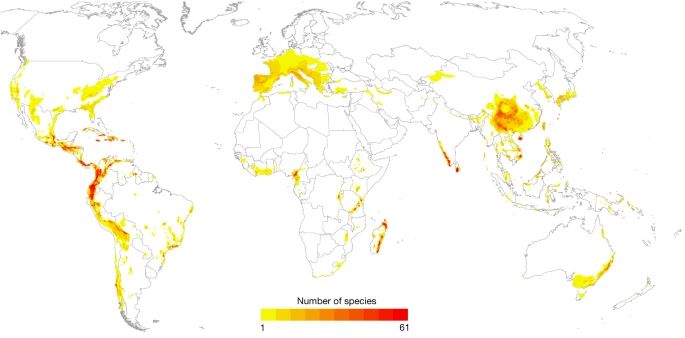Earth’s amphibian population is driven to extinction
Scientists working on the Global Amphibian Assessment, which encompasses data on 8,680 amphibian species, have discovered a dramatic decline in the number of frogs, toads, salamanders, and other amphibians due to the adverse effects of climate change and environmental degradation.
A recent study, featured in early October 2023 in the journal Nature, reveals that 41% of amphibian species globally, totaling nearly 2,900 species, are now classified as "globally threatened." This classification encompasses vulnerability, endangerment, or critical endangerment, and represents a troubling 3% increase since 1980, with no signs of slowing down.

The distribution of 2,873 globally threatened amphibian species. Credit: Nature
These findings confirm the consensus among scientists that amphibians currently constitute the most threatened vertebrate class on Earth.
To survive, then need to adapt or migrate as fast as possible amid the rapidly changing environment and habitat fragmentation.
Amphibians' unique feature of permeable skin allows them to respire both on land and in water, but it also renders them susceptible to dehydration in the face of rising temperatures and the absorption of pollutants. Their reliance on both aquatic and terrestrial habitats makes them doubly vulnerable to habitat loss and disruptions caused by factors such as storms, floods, droughts, and shifting climates, as per the study.
While climate change contributes significantly to their plight, agriculture remains the primary threat, affecting more than three-quarters of all impacted species. Agriculture is a major driver of habitat destruction, exacerbating the crisis. Additionally, the rapid spread of chytridiomycosis, a skin disease that impairs breathing and hydration, poses a severe threat to amphibians, particularly frogs.

The types of threats affecting amphibian species in threatened categories. Credit: Nature
While outlining the causes of the amphibians’ problems in this particular study, the researchers have not suggested any specific measures to rescue them other than addressing the human-made environmental disaster. But this effort may take too long before we can save our frogs and salamanders.
The study was conducted by an international team of biologists and environmentalists led by Canadian researchers.
***
Feel free to support our small office: RO50BTRLEURCRT0490900501 (IBAN for Rudeana SRL)
Not feeling like donating? Then click on banners on our website to generate ad revenue. Any help is welcome.







